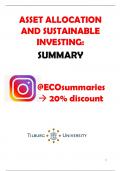Samenvatting
Asset Allocation & Sustainable Investing - Summary - Tilburg university - MSc Finance
- Vak
- Instelling
Instagram: ECOsummaries DM me for 20% discount! Summary for the course 'Asset Allocation & Sustainable Investing'. This summary was written in order to study for the final. Everything you need to know is available in this summary. Instagram: ECOsummaries DM me for 20% discount!
[Meer zien]



